ChiS&E’s Family STEM Day Helps Chicago Youngsters Progress Along the STEM Pipeline Toward Engineering
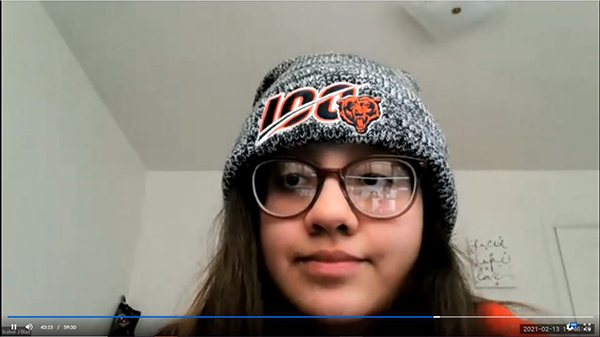
Isabel Diaz, a 5th year Civil & Environmental Engineering senior and long-time WYSE volunteer leads the young participants in the Hot Cocoa Machine mini-workshop.
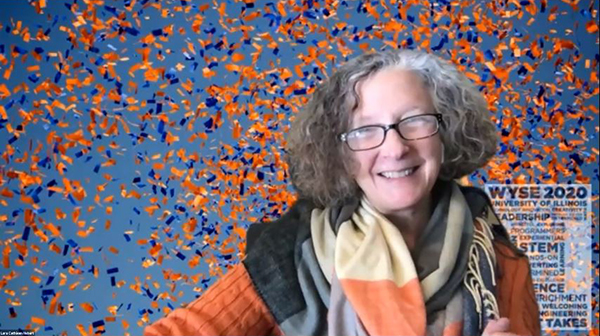
Lara Hebert, Grainger Engineering’s Outreach & Public Engagement Coordinator MCs the day's Final Showcase.
February 23, 2021
For Chicago kids (and parents) stuck inside because of the frigid winter weather, the ChiS&E Family Winter STEM Day on February 13th came just in the nick of time. A win-win for both the kids and their folks, the virtual outreach provided sessions and activities that were both educational and entertaining. For instance, parents discovered resources that might make sending their kids downstate to Illinois affordable. Plus, while doing creative, hands-on activities and bonding with the family over STEM, their kids learned a bit about the various engineering disciplines they were exploring. And hopefully, after successfully completing the activities, the kids discovered that they too have what it takes to become engineers someday.
The outreach was sponsored by Grainger College of Engineering’s WYSE (Worldwide Youth in Science and Engineering) program, as well as its long-time partner, the Chicago Pre-College Science and Engineering Program (ChiS&E) for Chicago kindergarten through 12th grade students. Also participating in the event were ChiS&E founder, Kenneth Hill, as well as LaTina Taylor, the program’s coordinator. Administrating the event was Lara Hebert, Grainger Engineering’s Outreach & Public Engagement Coordinator, who organized the day.
Helping to plan the event as well as lead the various mini-workshops were a number of Illinois students. For instance, leaders included current and former students in Hebert’s ENG 298 course, which addresses STEM identity development and instructional practices that offer an equitable and inclusive environment, and also offers students a chance to become mentors via the ChiS&E partnership. Also helping lead the event were members of several Illinois student groups, including WYSE LEAD, Tau Beta Pi, and Bioengineering’s Soft Robotics Researchers. Of course, the key participants were the Chicago K–12 students, and their parents who are involved in the ChiS&E program.
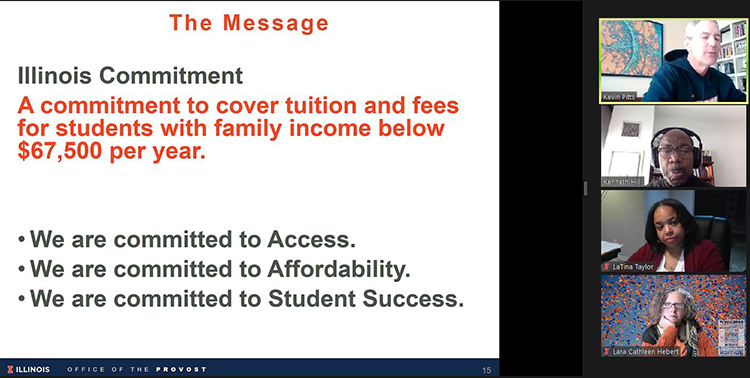
Slide Kevin Pitts showed during his "Affording College" presentation.
Held via Zoom on Saturday, February 13th, from 10:00 am–2:00 pm, the event began with "Affording College,” a presentation by Kevin Pitts, Illinois’ Vice Provost for Undergraduate Education, during which he addressed resources families might consider when planning for college. Some resources cited included grants, such as Pell and MAPS grants, which are need based and don’t need to be repaid, as well as scholarships, which also don’t need to be repaid, and can be based on need, merit, or both. Other types of aid included student loans and work study programs. Pitts also discussed Illinois programs, such as the First ARISE Scholars program, and the Illinois Commitment, which covers tuition and fees for Illinois students whose families make less than $67,500 a year. Finally, he recommended that students apply in a timely fashion (usually by early January at Illinois), and complete one’s FAFSA (Financial Aid, Federal Student Aid) application as soon as possible.
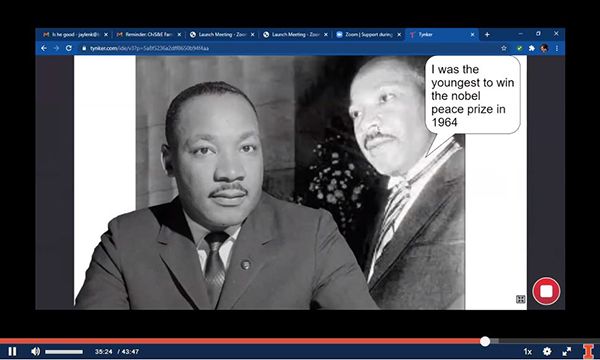
During the Final Showcase, one of the students in the “Inspiring Animations" mini workshop shows the animation he/she did about Martin Luther King. (See bottom of article for a look at the student's coding.
Next on the agenda, students participated in one of four discipline-related mini workshops they’d signed up for ahead of time and been mailed packets of materials. The four topics addressed four different engineering disciplines. For instance, “Break & Make It,” which addressed electrical engineering, was led by a regular WYSE volunteer, Harpal Singh. This activity was developed by Jana Sebestik from the Office of Math, Science, and Technology Education. The Civil Engineering “Structures” workshop, with its Gumdrop Tower hands-on activity was led by ENG 298 alum Lexi Frieman, plus Tonia Sajan Elengikal and Andrew DaPang from Tau Beta Pi. “Inspiring Animations,” about computer programming, was led by Mona Jawad and Peter Davis of Tau Beta Pi. Finally, the mechanical-engineering-related "Hot Cocoa Machine" activity was led by Isabel Diaz, a senior in CEE (Civil and Environmental Engineering), Shuen Wu, a freshman in ECE (Electrical and Computer Engineering) and Mayank Bhatia, a Computer Engineering major.
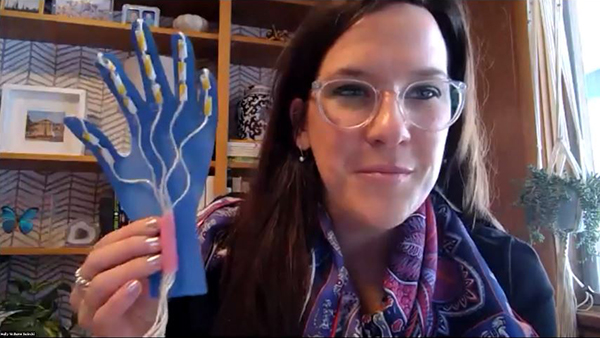
BioE Assistant Professor Holly Gollecki shows a prosthetic hand the Family STEM Day students were to make as part of her and her students' soft robotics presentation.
Following a lunch break, Bioengineering (BioE) Assistant Teaching Professor Holly Golecki and her team of soft robotics researchers, ECE juniors Alyssa Bradshaw and Adia Radecka and BioE senior Preston Njapa Njeuha, shared about soft robotics plus introduced a hands-on activity kids could do by cutting a “hand” out of construction paper, bending the fingers inward, then attaching straws and string to make a prosthetic hand.
The final activity of the day was the Family STEM Showcase, which featured group photos of participants in the various mini-workshops, plus several individual students who proudly showed off their creations.
Several Illinois students who helped lead the various activities share why they got involved and what impact they think the Family STEM Day had on the young participants. For instance, one Illinois student who participated was Harpal Singh, a senior pursuing a dual degree in Bioengineering and Chemistry. Singh says he got involved in WYSE outreach last winter when a friend recommended him to review applications for WYSE high school summer campers. “I really enjoyed the staff and their mission,” he reports, “so I applied to be a lead counselor for the camp in the summer, and I have been in WYSE ever since.” He now does a variety of outreach activities, including middle and high school activities with schools in the Chicago area, in addition to summer camp planning.
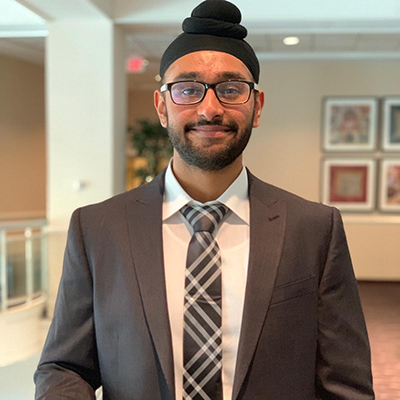
Illinois senior Harpal Singh, who led the Break It; Make It activity.
The Break It; Make It activity he led was in the electrical and computer engineering discipline. He and his young charges broke open a common Christmas ornament which lights up when it is moved or light changes. He showed the kids how to identify which parts of the ornament power it (a battery), make noise (the speaker), and allow the ornament to only turn on when there is movement nearby (a motion detector). Once they knew about these components, he challenged them to connect an LED light to the circuit of the ornament to make it light up.
“I hoped to impart to them a love of experimenting and the process of trying different things to see what works, similar to how engineering design is in real life,” he reports.
In terms of the impact his activity had on students and their parents, he indicates that they were “very happy and engaged once the LEDs were successfully connected. I could see both the bulb and their faces glow in excitement. I’m happy they enjoyed this activity.”
Helping to lead the Structures/Gum Drop Towers activity was Lexi Frieman, a junior studying Mathematics with a minor in Secondary Education. She got involved with the outreach because in Fall 2019, she took ENG 298, a course taught by Lara Hebert, indicating that the description about the mentor/mentee experience with ChiS&E had piqued her interest. At that point, she hadn’t yet applied for her minor in Secondary Education, but knew teaching was something in which she was interested.
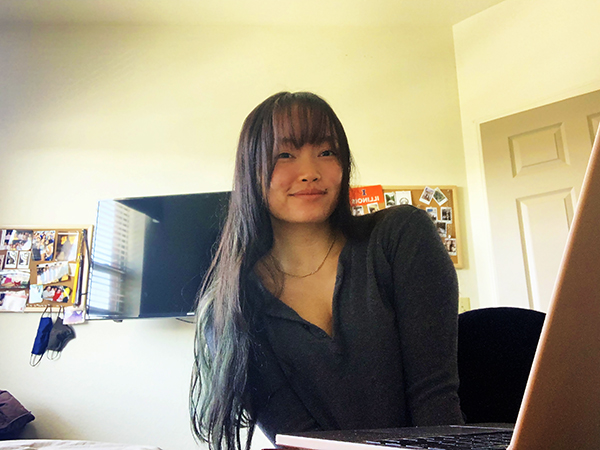
Lexi Frieman, who helped lead the Structures/Gum Drop Towers activity.
“ENG 298 seemed like a great opportunity to get my foot in the door with hands-on experience in a classroom setting,” she admits. “Volunteering for ChiS&E that semester was an amazing experience, and whenever I see the opportunity to take part in the program again, I always do! I love the energy and excitement for STEM that the kids and their families bring.”
Frieman’s goal in participating in the Family STEM Day was for the kids to build a fond memory involving STEM with their families, which she thinks many of them were able to do. She feels they built “memories they'll look back on in the future when considering what they would like to pursue. Sometimes STEM can feel intimidating, but I think many of them were able to experience the creativity the disciplines have to offer.”
In fact, Frieman urges her fellow students who haven't participated with ChiS&E before to do so, claiming it helped to steer her into her future career. “It truly was an experience I'll never forget,” she claims, “and was the stepping stone towards becoming a future educator for me.”
Leading the Hot Cocoa Machine mini-workshop was Isabel Jasmin Diaz, a first-generation college student and 5th year senior studying Civil & Environmental Engineering. Diaz has worked with WYSE programming and summer camps since 2017 as a counselor, lab assistant, and lead counselor.
One of the three Outreach Ambassadors in WYSE, Diaz has volunteered with ChiS&E since before the pandemic, when she worked in-person to help teach Scratch programming. “I got involved and stayed involved because this program specifically works with the same students each year as a sort of cohort,” she acknowledges, explaining that working with the same people can provide both the students and the volunteers with consistency. “I think it's important to provide equitable programs to students,” she adds, “especially ones that give experiences outside of a laboratory that show STEM in a fun, real-world relatable way.”
Working with 1st–5th graders, Diaz sought to teach her young proteges how to combine mechanical and chemical engineering elements to design and build a hot cocoa machine that would automatically mix up a cup of hot cocoa. To give students some ideas about what elements to include in their designs, the group first watched how a soda fountain works so they could learn how a similar machine works in real life.
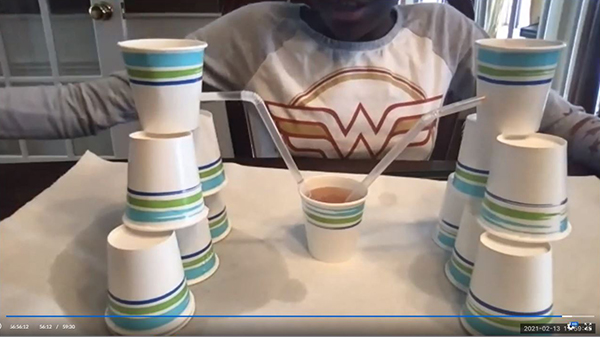
During the Hot Cocoa Machine mini workshop, a young participant shows off the innovations she made with her machine.
Then, using paper cups, a pencil to poke holes, separate milk and chocolate powders, and warm water, her students were to figure out how to get their cups to stack and stay stable, then choose the best hole placements so the water could flow through without collapsing their machine, mixing the two ingredients (milk and chocolate powders) that were in two separate containers, thus providing the students a cup of perfectly-made hot cocoa upon completing the project.
Also, in honor of Black History Month, the students also learned about Ursula Burns, who has a B.S. and M.S. in Mechanical Engineering, and was the first Black woman to become a CEO and to lead a Fortune 500 company—Xerox—in 2009. Says Diaz, “I hope the students could see themselves in this role model.” She also hoped the students would learn some key engineering principles: collaboration and persevering despite failures. For example, re collaboration, she hoped her students would “learn how to ask help from their parents with the project.” In regards to working through a problem, she hoped they would discover “that although a project is tough and could have a lot of failures in the beginning, that we can laugh it off and learn from those mistakes to come to a final, successful project.”
All in all, Diaz believes the activity had a positive impact on the kids…and their parents. For one, she feels one benefit was “connecting the students with their parents in their pursuit of STEM outside of the classroom. The students and their parents were so eager to get started with the project, and I hope their parents keep signing them and their friends up for these programs.” She also believes the students learned to problem solve. “The time went by so quickly, but each of the students came up with their own solutions and found different ways to overcome the difficulties of the project.”
Story and photographs by Elizabeth Innes, Communications Specialist, I-STEM Education Initiative.
Additional I-STEM web articles about ChiS&E:
- Illinois Undergrads Encourage ChiS&E CPS Students Toward Possible Careers in Engineering
- ChiS&E Program Exposes Chicago Public Schools Students to STEM...and Illinois
- Chicago Students Experience STEM, Illinois During ChiS&E Campus Visit
More: 6-8 Outreach, Chicago Public Schools, ChiS&E, Underserved Minorities, 2021
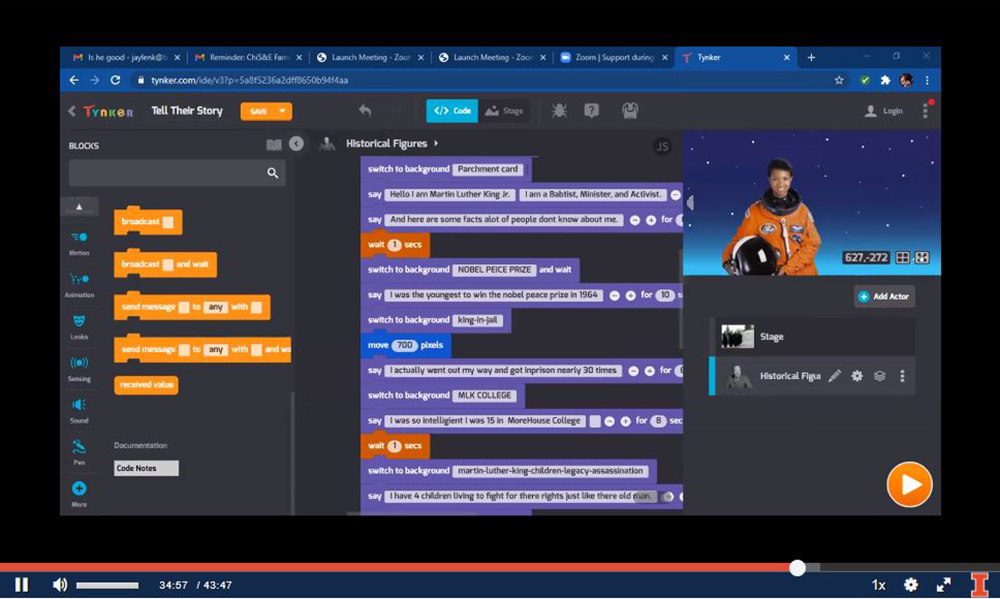
During the final showcase, a student shows the coding they did on tynker.com as part of the “Inspiring Animations" mini workshop.













.jpg)
















